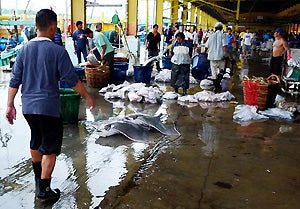
In response, researchers from the Centre of Excellence for Research in AIDS at the University of Malaya in 2008 initiated Project Waves to conduct a preliminary study on drug use and HIV risks among fishermen from the port city. In 2010, the University of Malaya then invited the World Bank to partner in the important initiative. The World Bank gave technical support for a bio-behavioral survey.
Four hundred and six fishermen participated in the study and the survey results were completed in 2012. The results were both surprising and breakthrough:
- More than one in three fishermen in our sample injected drugs and more than one in ten were HIV positive. This is over 20 times the HIV prevalence among the general population of Malaysia.
- 71% reported having used drugs in the vessel while on fishing trips, of whom 72% said that their skippers knew of their drug use, and 63% have used drugs with other crew members.
- The level of HIV infected fishermen, in this sample, is at the same level as that of female sex workers in Kuala Lumpur, the capital city of Malaysia. Around 10% of female sex workers in Kuala Lumpur have HIV and this may be considered high, given that prevalence of the general population in Malaysia is 0.5%.
- Unlike fishermen from Thailand and Cambodia, where HIV is transmitted mostly through unprotected sex, only a quarter of respondents were sexually active.
- Condom use among those who were sexually active in the port city were low, with only slightly more than a quarter having used condoms during sex with their primary partners.
This finding raised many interesting questions. Are the high HIV figures an anomaly or a general trend among fishermen in Malaysia? Why do the fishermen inject drugs? While we are conducting more research to address these questions and to dig deeper into the connections between fishermen, HIV, and drug use, Project Wave will be providing basic healthcare for the fishing community, through a seed grant from the Malaysian AIDS Council's Community Action for Harm Reduction, a program funded by the International HIV and AIDS Alliance. Through this, we hope to provide services like wound care and also set up a referral system to medical services.
We are also holding discussion with the National Anti-Drugs Agency to adopt this healthcare provision model as a platform to encourage fishermen who have an issue with drug use to access opioid substitution therapy. Thus the story comes in a full circle – the harm reduction initiative that currently addresses HIV among fishermen could in the future be addressing drug use in this community. To this end, we are encouraged and hopeful.


Join the Conversation